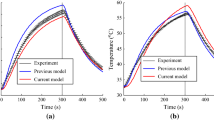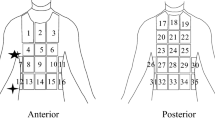Abstract
The specific properties of porous materials when wet, namely the cooling effect near the surface due to the heat extraction during water evaporation, were known and used by ancient civilisations. During human perspiration, the necessary heat for sweat evaporation is provided by the cutaneous surface, which induces a temperature drop similar to that observed in a wet porous material. The potential for using porous materials to simulate human perspiration was investigated in this work using different permanently saturated porous materials (plaster, white clay and red clay). The existence and duration of a constant drying rate was studied, as well its dependency on the surrounding conditions, namely temperature, moisture and velocity. We verified the existence of a period with constant drying rate for all the tested samples; this is evidence that a uniformly distributed humid layer is formed and stays on the external surface of the porous body. This represents a step forward in simulation of the sweating mechanism. All three tested porous materials showed very good reproducibility and good sensitivity in terms of the response of the evaporation rate to any variation of the relative humidity.




Similar content being viewed by others
References
Bruhwiler PA (2003) Heated, perspiring manikin headform for the measurement of headgear ventilation characteristics. Meas Sci Technol 14:217–227
Cengel YA, Boles MA (1994) Thermodynamics–an engineering approach, 2nd edn. McGraw-Hill, New York
Chen P, Pei CT (1989) A mathematical model of drying processes. Int J Heat Mass Transfer 32:297–310
Frankenberger RT, Nahim W, Konecny E (1997) Development of a premature baby simulator. World Congress on Medical Physics and Biomedical Engineering, Nice, France.
Harmathy TZ (1969) Simultaneous moisture and heat transfer in porous systems with particular reference to drying. Ind Eng Chem Fundam 8:92–103
Nasrallah SB, Perre P (1988) Detailed study of model of heat and mass transfer during convective drying of porous media. Int J Heat Mass Transfer 31:957–967
Nevins RG, Darwish MA (1970) Heat transfer through subcutaneous tissue as heat generating porous material. In: Hardy JD, Gagge AP, Stolwijk JA (eds) Physiological and behavioral temperature regulation. Thomas, Springfield, Ill., pp 281–301
Acknowledgements
The first author acknowledges a grant from the European Programme PRODEP, which supported his doctoral project.
Author information
Authors and Affiliations
Corresponding author
Rights and permissions
About this article
Cite this article
Mendes, J.C.A.F., Silva, M.C.G. On the use of porous materials to simulate evaporation in the human sweating process. Eur J Appl Physiol 92, 654–657 (2004). https://doi.org/10.1007/s00421-004-1131-4
Accepted:
Published:
Issue Date:
DOI: https://doi.org/10.1007/s00421-004-1131-4




